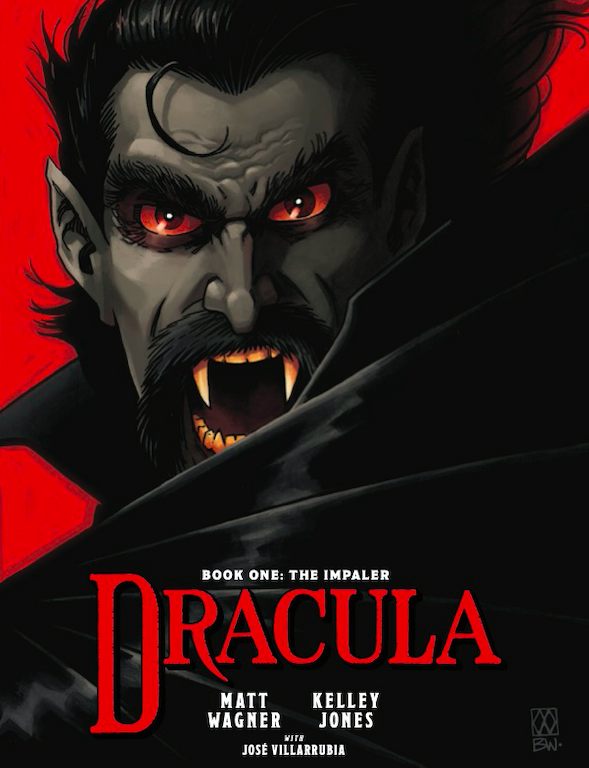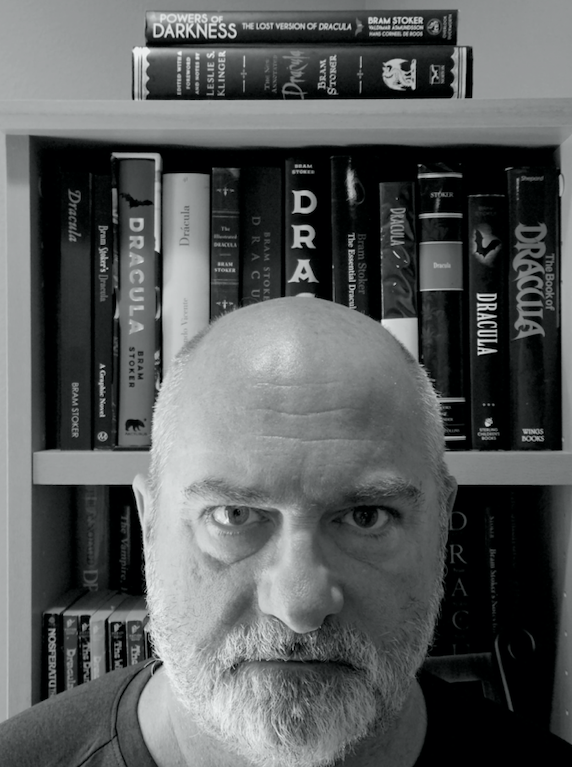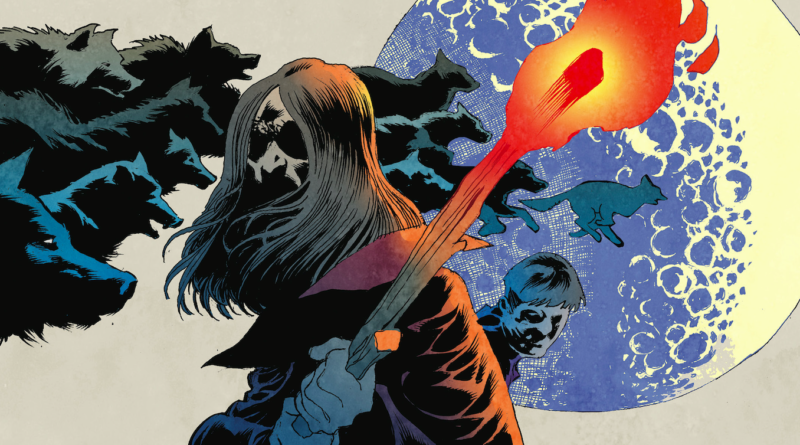INTERVIEW: Matt Wagner digs up the crypt of Dracula for new project
Image courtesy of Orlok Press / Provided by Superfan Promotions with permission.
Dracula, that vampire of lore who has haunted screens, stages and pages for more than a century, is back in Matt Wagner and Kelley Jones’ new graphic novel series. Dracula — Book One: The Impaler, which is currently raising funds via Kickstarter, promises a behind-the-scenes tale based on the count’s “rich history and persona.” This first of four volumes focuses on Dracula’s coming of age in Satan’s school of the dark arts, Scholomance, according to press notes.
Wagner, known for his Grendel series and his work on Batman, Sandman and Green Hornet, is the writer of the new book, while Jones, known for Deadman and Sandman, is the artist. Together they are a dream team for comic book and graphic novel lovers. One only has to look at the amount of money that’s been pledged for the project to see the enthusiasm for their shared vision: $230,000 as of Wednesday, Nov. 15, with only two days left in the campaign.
Recently Hollywood Soapbox exchanged emails with Wagner about the new project (a similar interview with Jones will be released soon). Questions and answers have been slightly edited for style.
When did you first encounter the Dracula story? Was it a movie adaptation? The original novel?
WAGNER: I really can’t recall a time when I wasn’t aware of Dracula. I’ve been a comic book reader my entire life, and there have always been vampires cropping up in comics since their inception. One of Batman’s very first Golden Age villains was the Mad Monk, who’s also a vampire (a tale that I later modernized in my own series, Batman & The Mad Monk). Even though the censorious and now-obsolete Comics Code Authority tried for years to keep the depiction of such monsters [out] of the supposed “kids entertainment,” they somehow crept in around the edges.
I’m guessing the classic 1931 film with Béla Lugosi must’ve been my first cinematic introduction to the character, and then, of course, there are a million riffs and variations based on that portrayal, from The Count on Sesame Street to the fact that every vampire Halloween costume even up until today involves some variation of Lugosi’s image in the role. But eventually I saw other Dracula films, most notably a few of Christopher Lee’s iconic turns at the role and, very contemporary for me at the time, the Dan Curtis-produced TV film version starring Jack Palance as Dracula and (unknown to me then) a script adaptation by renowned writer Richard Matheson, author of the classic vampire novel, I Am Legend. I say that TV film was important to me at the time because this was in the days long before any sort of video-on-demand or even VHS tapes. To catch any viewing of your favorite films, you had to studiously review the published broadcast schedules for any given week and make sure to tune in at those times; there were no reruns, per se.
I even did a school report on Dracula in seventh grade wherein I managed to catch a showing of the Lugosi film and sat close to our TV set with a handheld cassette tape recorder and taped certain famous catch phrases from the film that I later played back for the class. Around that same time, I think I read Bram Stoker’s original novel for the first time. Our school library had a copy that intrigued me because the cover illustration depicted Dracula as he’s described in the novel, with deadened, almost bluish skin, sweeping white hair and a long mustache. That wasn’t like any film interpretation I’d ever seen so it really grabbed me … by the throat, you could even say.
But anyone who’s a fan of the novel knows that Dracula is, in fact, off-stage for a lot of the narrative. He’s more or a shadowy presence whose actions invade and infect those around him. As a result, I’ve always wanted to know more about the character’s history and persona that I would often find myself filling in those tantalizing gaps in the narrative. So it’s fair to that these stories that have literally haunted my imagination for, yes, decades.
Do you feel there’s a lot of backstory still to mine on this iconic character?
WAGNER: Bram Stoker’s classic novel creates and portrays arguably the most famous literary character of all time, but, as I said, it leaves many aspects of Dracula’s history and persona only hinted at and thus incredibly intriguing and mysterious. Dracula is such a compelling character, but he’s off-stage for a lot of the [actual] narrative. That in itself lends proof to how powerful and magnetic his character is portrayed. Even from the shadows, he’s captivated audiences for over a hundred years.
In fact, since it’s original publication in 1897, the novel has never been out of print. The more I’ve thought about the unspoken, implied history of Dracula’s backstory, the more I became convinced that this was a rich and viable avenue for telling all-new tales about the character. We’re taking all the cryptic details Stoker unveils and using those to create our version of this iconic character’s history. And I want to make it clear … this isn’t yet another retelling of the novel in comics form. We’re bringing you the never-before told stories behind the story … the sinister tales hidden in and around the narrative of the original novel.
Our first graphic novel explores Dracula’s bloody history and his tenure at Satan’s legendary seminary of the dark arts, the Scholomance, a fact of his history that’s mentioned twice in the novel. We learn what led Dracula to seek out Satan’s tutelage and how he became the lord of the undead. And Book One: The Impaler is the first of a planned four-volume series of graphic novels. So, I think there’s a lot of backstory there … and Kelley and I are going to dig them all up for you.
How did the collaboration with Kelley Jones go? How did you trade ideas?
WAGNER: Kelley and I have been friends for many years, and we’d always intended to collaborate on something significant … not just a short story or one-shot. Finally, we both realized that the time was right, and, luckily, I had something in mind that perfectly fit our mutual energy and styles. Kelley’s an absolute master of the macabre, so when I felt like it was finally time to bring my Dracula obsession into narrative reality, there was just no better choice of collaborator. And our collaboration here just couldn’t have been any smoother … it literally feels like we’ve been working together like this for decades — an incredible synthesis of our two lengthy and accomplished careers in comics. Throughout this entire process, I was scripting these tales and writing to what I saw as Kelley’s strengths and always thinking to myself, Man, Kelley is gonna draw the hell outta this! And then, he’d send me this fucking magnificent art, and it always proved to be even more dramatic and visceral than I’d ever dared hope. This really has been a dream project for both of us.
Are you still amazed by the continued success of Grendel?
WAGNER: I suppose I am amazed in that I never imagined a concept and character that I first created when I was 20 years old would still be a vital and fertile narrative canvas for me after more than 40 years. But, quite luckily and not by any far-reaching design, I early on stumbled upon the idea of having Grendel being a generational character, providing the opportunity for the title to continually reinvent itself. As a result, I’ve been able to always branch off in new directions with Grendel, not only in regards to the stories and characters but also the storytelling methods and art styles. I’ve always felt like I need to stay ahead of my readers’ expectations and take them places they never imagined. And that philosophy works when pointed in the other direction as well. I need to have the kind of freedom and range that Grendel has provided me over the years; if the title isn’t continually fresh and interesting for me, then that’s not going to translate into an exciting experience for my readers. To my mind, there’s never been a comic series with the sort of range and diversity of Grendel, so, in that sense, I don’t find it surprising at all that readers would still find it fresh and dynamic.
Did you want to have your vampires follow the established rules of the genre (garlic, sunlight, etc.), or did you want no restrictions?
WAGNER: The basis for our Dracula series centers on the source material, the original novel, and we’ve tried to stick to those specifics as closely as we can while still enjoying the freedom to add to the legend. Author Bram Stoker not only provides many evocative hints as to Dracula’s history, he also, through the character of Professor Van Helsing, provides a fairly complete overview of the title character’s supernatural powers and limitations as well as vampires in general. But there are some variations within those supposed “facts.” For instance, no surprise, Dracula seems to be far more powerful than any of the other vampires we encounter in the novel’s narrative — all of whom are women, by the way. The only other character under Dracula’s obvious influence, the “madman” Renfield, isn’t one of the undead but rather a still-living slave to the vampire lord’s command.
Our first volume — The Impaler — explains why and how Dracula came to wield so many other powers. During Van Helsing’s various explanations is the all-but-forgotten assertion that Dracula (presumably while he was still alive) attended the Scholomance, a legendary seminary for the dark arts hosted by Satan himself. In our story, we learn what led Dracula to seek out Satan’s tutelage and how he became the lord of the undead. We also have to consider the fact that, though Van Helsing is a man of science, the vampire doctrine he’s imparting to the novel’s motley band of heroes is, in fact, folklore. And, as such, some of its specifics might prove to be more reliable than others.
There’s also some confusion caused by the influence of the many various screen versions over the years. For instance, in Stoker’s novel, sunlight isn’t lethal to vampires. In the book, Dracula walks around freely during the daytime although he is less powerful than at night, most specifically he can’t transform into either animal form or insubstantiate and pass through barriers as a mist. The concept of sunlight killing a vampire is, strangely enough, introduced in the very first, and unauthorized, screen version of Dracula, director F. W. Murnau’s classic silent film Nosferatu. The other three books in our Dracula series will reveal these and many other aspects of Dracula’s life and story that take place in and around the events portrayed in the novel.
By John Soltes / Publisher / John@HollywoodSoapbox.com
Dracula — Book One: The Impaler, written by MattWagner and with art by Kelley Jones, is raising funds via Kickstarter. Click here for more information.



